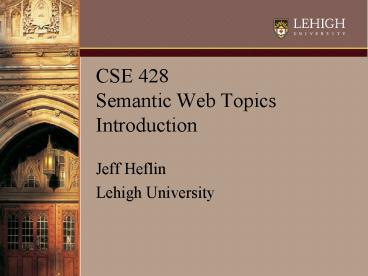CSE 428 Semantic Web Topics Introduction - PowerPoint PPT Presentation
Title:
CSE 428 Semantic Web Topics Introduction
Description:
Title: Knowledge Representation Issues for the Semantic Web Author: Jeff Heflin Last modified by: heflin Created Date: 5/27/1995 8:07:50 PM Document presentation format – PowerPoint PPT presentation
Number of Views:44
Avg rating:3.0/5.0
Title: CSE 428 Semantic Web Topics Introduction
1
CSE 428Semantic Web TopicsIntroduction
- Jeff Heflin
- Lehigh University
2
The Semantic Web
- Semantic Web
- Semantic "of or relating to meaning in language"
(Def. Websters) - Web The World Wide Web
- Official Definition
- The Semantic Web is not a separate Web but an
extension of the current one, in which
information is given well-defined meaning, better
enabling computers and people to work in
cooperation. (Berners-Lee et al., Scientific
American, May 2001)
3
Why Study Semantic Web?
- Open source Semantic Web tools
- from IBM, Hewlett-Packard, Nokia, etc.
- Commercial software vendors
- Oracle 11g RDBMS supports RDF and much of OWL
- Adobes products use RDF to provide metadata for
documents, photos - Semantic Web specific companies TopQuadrant,
Aduna Software, etc. - 65 million Semantic Web documents (as of
October 2009) - Yahoo SearchMonkey uses RDF to present richer
search results - Google now indexes RDFa (a means for embedding
RDF in web pages) - Semantic Web enabled sites
- Data.gov much of U.S. governments open data is
available in RDF - Newsweek annotates articles with RDFa
- BBC Music exports RDF playlists, RDF for all
artists - Harpers Magazine connects articles to events on
a timeline - DBPedia a Semantic Web version of Wikipedia
4
Semantic Web Standards
World Wide Web Consortium (W3C) Recommendations
- RDF(S) (1999, revised 2004)
- essentially semantic networks with URIs
- XML serialization syntax
- OWL (2004)
- extends RDF with more semantic primitives
- based on description logics (DLs)
- has a model theoretic semantics
rdfsClass
rdfProperty
- ltowlClass rdfIDBandgt ltrdfssubClassOfgt
ltowlRestrictiongt ltowlonProperty
rdfresourcehasMember /gt
ltowlallValuesFrom rdfresourceMusician /gt
lt/owlRestrictiongt lt/rdfssubClassOfgtlt/owl
Classgt - A Band is a subset of the groups which only have
Musicians as members
rdftype
rdftype
gPerson
rdftype
rdfsdomain
rdfssubclassOf
uChair
gname
rdftype
gname
John Smith
5
Semantic Web Layer Cake
From W3C (March 2007)
6
The End
7
Motivation
- How to answer these queries?
- find all bills dealing with energy that have
been sponsored by Congressmen from states with
populations less than 1 million - retrieve a list of all papers authored by
NSF-funded individuals who are located in states
in the Midwest - find a potential collaborator by identifying a
friend-of-a-friend who has written an article on
a related topic
8
The Semantic Web
- Definition
- The Semantic Web is not a separate Web but an
extension of the current one, in which
information is given well-defined meaning, better
enabling computers and people to work in
cooperation. (Berners-Lee et al., Scientific
American, May 2001) - Ontology
- a key component of the Semantic Web
- ontologies define the semantics of the terms used
in semi-structured web pages - identify context, provide shared definitions
- has a formal syntax and unambiguous semantics
- inference algorithms can compute what logically
follows
9
A Web of Ontologies
S1
S2
commits to
extends
Foaf
Dublin Core
Region
extends
extends
extends
Congress
extends
extends
DBLP
Citeseer
commits to
commits to
AIGP
NSF Awards
commits to
S3
S4
S7
commits to
commits to
The answer to a users query might require the
combination of data from S1, S2, S3, and S4.
S5
S6
10
URIs and Namespaces
- URI
- Uniform Resource Identifier
- includes URLs
- but also anything that you can design an
identification scheme for - helps to prevent collision of names
- all the symbols in RDF are either URIs or
Literals - Namespace
- a mechanism for abbreviating URIs
- by assigning a prefix for a URI fragment
11
Description Logic (DL)
- form of knowledge representation
- useful for formally defining classes
- studied extensively in 1990s
- mature reasoning software
- e.g., FaCT, RACER, Pellet
- benefits
- optimized computation of subsumption
- calculate implicit subClassOf relations
- ontology integration
- if two ontologies are related via class
expressions then subsumption can be used to
compute an integrated ontology
12
OWL Class Constructors
example taken from Ian Horrocks
13
OWL Axioms
example taken from Ian Horrocks
14
Common Criticisms
- Who will create all of the RDF/OWL data?
- How do you integrate heterogeneous ontologies?
- How can you handle spam / deceit /
misinformation? - How can a system based on formal logic achieve
Web scale?
15
Semantic Web Challenges
- The Web is distributed
- many sources, varying authority
- inconsistency
- The Web is dynamic
- representational needs may change
- The Web is enormous
- systems must scale well
- The Web is an open-world
16
Semantic Web Timeline
May 2001 Berners-Lee et al. Scientific
American article
Mar. 1996 - SHOE 0.90 (simple frames in HTML)
Feb. 1998 XML (semi-structured data for Web)
Feb. 1999 RDF (semantic nets in XML)
Feb. 2004 OWL (W3C Rec.)
1996
2004
2000
2002
1998
Jan. 1998 SHOE 1.0 (frames Horn logic)
Sep. 1998 Berners-Lees Semantic Web Roadmap
Mar. 2001 DAMLOIL (expressive DL in RDF)
June. 2002 1st Intl Semantic Web Conference































